« January 2012 | Main | March 2012 »
February 28, 2012
Black Ghost
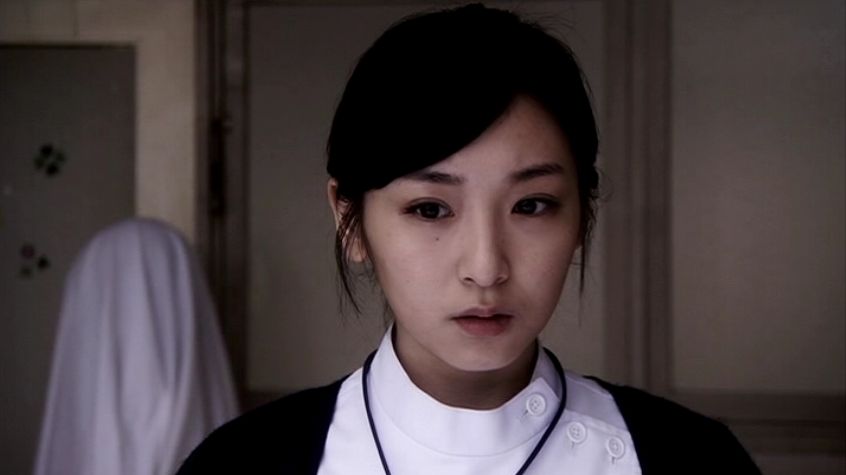
Kuroi Shojo
Mari Asato - 2009
J-Bics Region 3 DVD
I decided not to let February go by this year without a nod to "Women in Horror Recognition Month". Especially after reading this editorial from Fangoria Magazine, welled a feeling of some kind of gallantry, if that's the right word. I mean, I like eye candy as much as most other guys, and the proof is in some of my screengrabs, but these guys in Fangoria act like there's no female talent on the other side of the camera. And since most of the contributions are on English language talent, I figured I'd chip in on a film by an Asian filmmaker.
I don't know much about Mari Asato. She did serve as an actress and Assistant Director on Sodom the Killer, a pretty good film as I recall. She's also made a film with the delightful title of Samurai Chicks which is about a dance school that is a cover for women learning movements of a lethal variety. Another of Asato's films is titled The Boy from Hell, about the extremes of a mother's love for her son. Based on her filmography, Asato has several horror films to her credits.
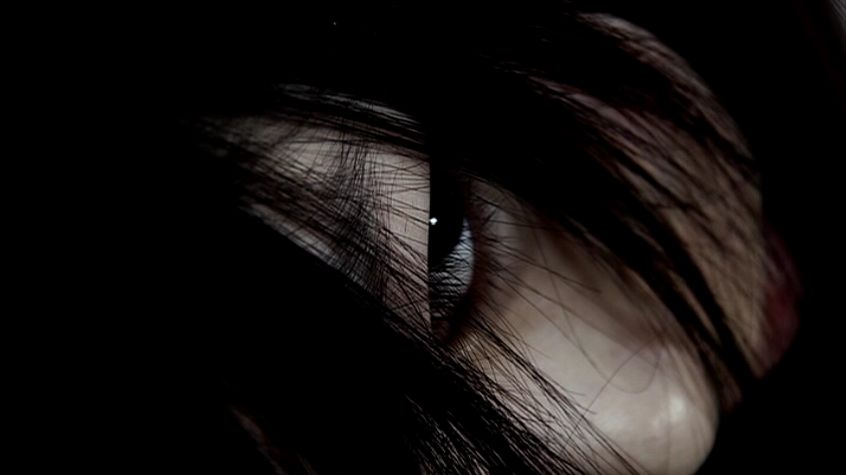
Black Ghost is the second half of two films running less than an hour each, part of Ju-On 4. The story is not directly related to the original series, which to me is not important, although it was by Takashi Shimizu, the creator of the series. Because I wasn't paying attention at the time of purchase, what I saw was a Thai DVD with no English subtitles. If getting the plot points is that important, they can be found at IMDb among other places. What struck me was the dismissal of Asato's film by the critics I've read.
Maybe because I saw the film without subtitles, I was able to appreciate the craft of the filmmaking. Is Black Ghost scary? No. But it does have its moments of creepiness. And Mari Asato has a better sense of where to put a camera, more so that some guys who've managed to wrangle Academy Award nominations. What I liked about Black Ghost were the faces and the use of shadows. Asato has a taste for tracking shots as well. Everything is cleanly composed. A favorite moment involves a woman, walking alone along a dark street. You have the sense that something unexpected could happen. It's the kind of scene that you'd often see in the horror films produced by Val Lewton, who's frequent protagonists were women in some kind of supernatural danger.
If a film like Black Ghost is worth writing about, it for this reason: sometimes good craftsmanship should be appreciated for its own sake. Not every film has to have lofty artistic or philosophical goals, and most of them don't. For myself, I see more than enough contemporary filmmakers without the sense of where to put a camera, how to block a shot, or how to visually relay a story economically. Mari Asato may currently be the equivalent of the more than competent "B" filmmakers of the past, but as the longer view of film history has proven, that's really not a bad place to be.
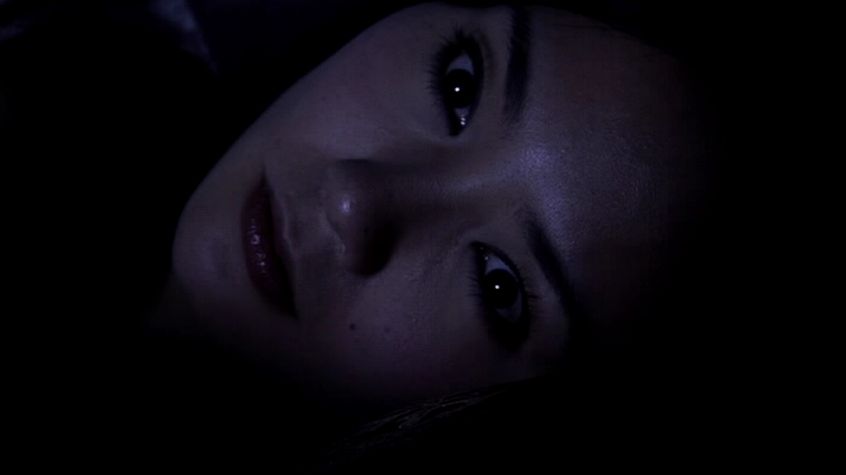
Posted by Peter Nellhaus at 08:31 AM
February 26, 2012
Coffee Break

Rachel Weisz in The Brothers Bloom (Rian Johnson - 2008)
Posted by Peter Nellhaus at 10:48 AM | Comments (2)
February 23, 2012
Confessions
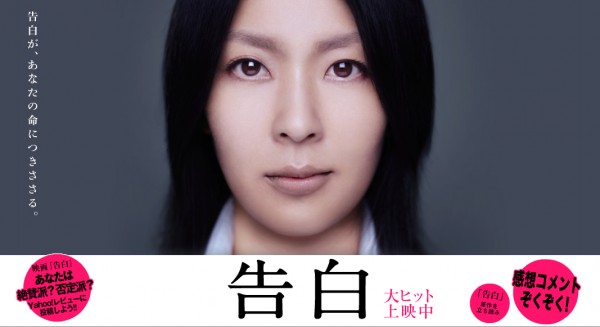
Kokuhaku
Tetsuya Nakashima - 2010
Third Window Films Region 2 DVD
Suzanne Vega once wrote, "Blood makes noise". Blood makes plenty of noise here as Confessions is in part about HIV, family relationships, and about bloody revenge. That this discomforting film was chosen as Japan's entry for the the foreign language film Oscar showed some courage. That Confessions never received distribution in the U.S. is not surprising.
Without giving too much away, the basic setup is of a teacher on her last day at school. She talks about a celebrated teacher with a best selling book. The man is revealed to have been her husband. The two had a young daughter. The young daughter dies in an accident according to official records. According to the teacher, her daughter was murdered by two of her students in the classroom. The narrative is in separate chapters, from the point of view of four main characters, presented as their confessions.
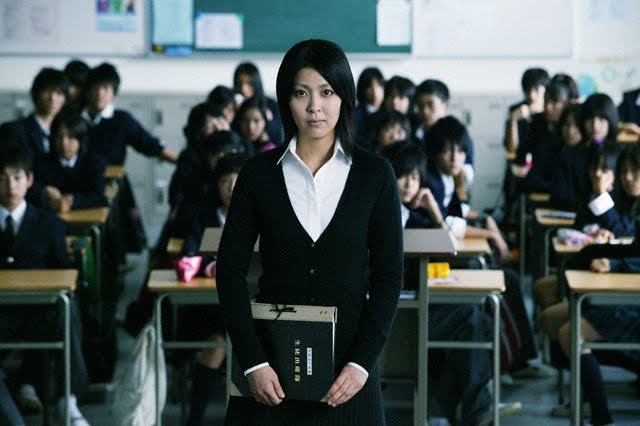
I am not familiar with the source novel by Kanae Minato. I would imagine it is primarily an indictment of Japanese society, as well as a legal system that is lenient to even the most vile of juvenile offenders. The students here are in the equivalent of Junior High School, about thirteen years old. I don't feel the need to link to current news stories to indicate that what takes place in the film has reverberations beyond Japan. There are enough news stories about bullying and callous behavior to make Confessions hit home, no matter where you call home.
As far as the content of the film goes, it may be best to let it speak for itself. It is the kind of work that invites discussion about individual and collective responsibility.
What also interest me is how Tatsuya Nakashima has made a film that in content is more serious than Kamikaze Girls or Memories of Matsuko, yet connects with the previous films. The outsider status in Kamikaze Girls is established by the choice of the two young women to dress in styles that are idiosyncratic, but more so with their living in rural Japan. In Confessions the status of outsider is conferred internally as well as externally. The students, both female and male, wear the traditional dark blue uniforms. Even the clothing worn by the teacher is not too different, with solid dark blue dresses. Even though the film centers on four characters, there is the implication that almost everyone here feels a sense of alienation from themselves and others. The title also carries the weight of irony when we see that not everything shown or heard is necessarily true, as the respective narratives are contradicted or given additional information.
Confessions is also as visually stylized as any of Nakashima's previous films. Where a DVD supplement proves valuable is in Nakashima explaining how he not only created storyboards for every shot, but essentially made a video version to use as a guide in making the film. Some of this stylization comes in the form of editing of a succession of quick, almost abstract, images. There is also the digital raindrops, and the bubbles that seem to pop out of one of the student's ears. There is also the choreography with the students dancing to "That's the Way (I Like It)", and a scene near the end, an overhead shot of the students gatherer in circle around one young man.
The center of the film is Takako Matsu as the teacher. No fragile flower here, but someone with understated reserves of steel. The final shot of Matsu is with tears in her eyes. Yet even when she appears to have tipped her hand, she let's you know that perhaps all is not quite as it appears.
Posted by Peter Nellhaus at 09:01 AM
February 21, 2012
War of the Arrows

Choi-jong-byeong-gi Hwal
Kim Han-min - 2011
Well Go USA Region 1 DVD
War of the Arrows takes place in the area where Korea shares a border with Manchuria, in 1638. Compared to what was happening in Europe at the time, the culture and the battle armor worn by the soldiers here made me think of a more Medieval period. One could, with only a few changes, easily transpose the film to that earlier era of chivalry, something along the lines of Antoine Fuqua's King Arthur
The film starts breathless from the get go, as a young man and a girl are hiding from some enemy soldiers. It is revealed that their father, who held some kind of court position, has been labeled as a traitor. The son, Nam-yi promises his dying father that he will do everything he can to protect little sister, Ja-in. The two are reluctantly taken in by Lady Kim, whose young son, Seo-goon, immediately has his eye on Ja-in. Fortunately, the little girl who can't stop crying and whining in those first scenes grows up to be a beautiful, and composed, young lady. Fast forward to thirteen years later, Ja-in is preparing to marry Seo-goon when the festivities are disrupted by invading solders. Taken prisoners by the Manchurians, Nam-yi travels north to rescue the pair.

War of the Arrows was the second most popular Korean film of 2011. It's a good film, yet I think it would have been better had Kim Han-min not relied so much on hand held camera work. I understand that it seems for some to add to a sense of immediacy. Call me old fashioned, but it didn't always work for me. What did work, and what I suspect helped make the film a hit is watching the clean shaven, boyish Seo-goon show his mettle against the Manchurians, as well as watching Nam-yi try to outrun and outwit the better armed soldiers, running through the woods, and into physically challenging situations.
It helps that Park Hae-il comes off in his first scenes as a person who earns his heroism by sheer skill and tenacity. Aside from a couple of comic sidekicks, he's alone in the world, save for Ja-in. It is the kind of performance that brings to mind Toshiro Mifune, especially in the earlier films with Kurosawa, where we have a sense of both the outsider pushing his way through the world, and that same person's bouts of self-doubt or weakness. And who doesn't like women who kick ass? Certainly no one who usually visits this site. No surprise that Moon Chae-won has won awards and lots of attention as Ja-in, taking on all comers with sword and bow. A veteran of several Korean television series, this is an auspicious feature film debut.
Attention has been paid to period accuracy regarding the design of the bows and arrows, as well as some remarkable costumes from the era. The Manchurians are definitely a sight to behold with their heavily studded leather outfits, and custom shaved pates. Sure, the Manchurians are out to rape and pillage, but they dress to kill.

Posted by Peter Nellhaus at 09:22 AM
February 19, 2012
Coffee Break

Tom Hardy and Nick Nolte in Warrior (Gavin O'Connor - 2011)
Posted by Peter Nellhaus at 08:39 AM
February 16, 2012
Age of Assassins

Satsujin kyo jidai
Kihachi Okamoto - 1967
The film opens with shots of inmates behind bars in a highly styled insane asylum. The biggest lunatic is the doctor who runs the joint, Mizorogi. As part of a group with Nazi ties, his plan is to transform his patients into professional killers, all in the name of population control. What gets in the way is that one of his intended victims, a grubby professor of criminal psychology, Shinji, confounds everyone when his would-be killers unintentionally cause their own deaths.
The opening credits are made of cartoons setting up the cheerful black humor to come for the next hour and a half. The visual style is influenced by pop art. There is a lot of emphasis on forced perspective, differences in size, or simply framing people so that it looks like part of a comic book panel. Some of the signs are oversized. Age of Assassins is hardly subtle, even when the characters spout philosophy. The film is so at ease in its own goofiness as to have one characters, an inept car thief, named Otomo Bill (some may have to hear it aloud a couple times to get the joke).
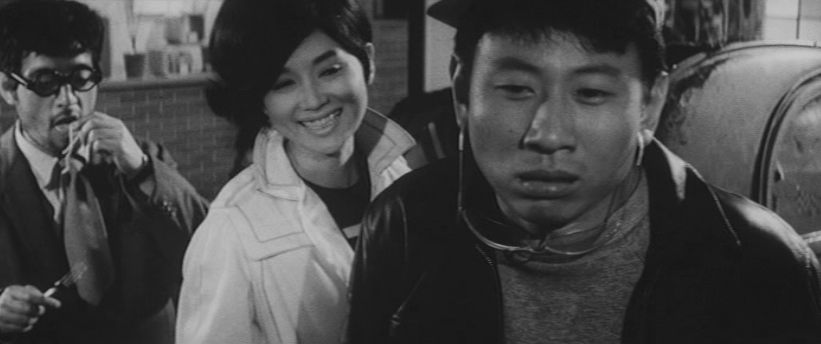
At the heart of it all is Tatsuya Nakadai. In this case, an unrecognizable Tatsuya Nakadai. For those less familiar with the long time star of Japanese cinema, Nakadai can't be missed because he's taller than everyone else, just a shade under six feet. Often a brooding samurai, Nakadai can also show his sensitive side in the Human Condition trilogy. But I couldn't recognize that guy for the bumbling academic, unshaven and generally unkempt, with glasses with the thick black frame, stooped over, with the chronic athlete's foot, always thinking of his dead mother. Of course all goes well when the dapper, well groomed Tatsuya Nakadai shows up on the screen.
In a movie like this, you need the villain to be equally powerful. Hideyo Amamoto's name may not be recognizable, but some might remember him best when Woody Allen dubbed him with the imitation voice of Peter Lorre for What's Up, Tiger Lily. With the wild hair and the too wise mouth, it's as if Amamoto was the living personification of every mad scientist who appeared in every anime and manga. Reiko Dan usually is known for supporting roles in the more stately film by Ozu, Kurosawa and Naruse, among others. As the writer for a mystery magazine, Dan joins forces with Nakadai in pursuit of an exiting story, and provides some eye candy with a nude scene, where props are arranged to hide all but enough to give the audience a good idea of what's going on.
What I love about Age of Assassins is that it fits in with other films of the 1960s, most notably those by Seijun Suzuki, where filmmakers were hired to do genre films, but seemed to have a free hand in creating highly stylized works. Tom Mes might be generalizing a bit on Okamoto and filmmakers of his generation. While films of a somewhat younger generation by Nagisa Oshima and Susumu Hani may have been more deliberately created as art cinema, there is the shared sense of busting taboos and creating dynamic visuals. The best thing about Age of Assassins is that it's fearless in its embrace of the ridiculous.

Posted by Peter Nellhaus at 07:33 AM
February 14, 2012
Cyrano Agency
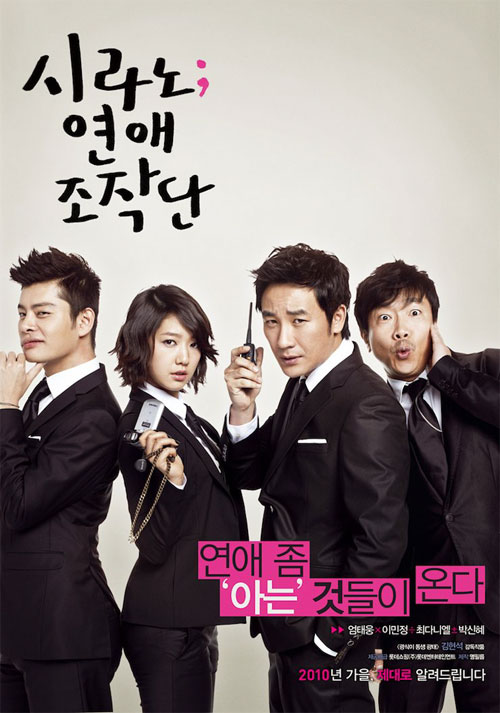
Si-ra-no;Yeon-ae-jo-jak-do
Kim Hyeon-seok - 2010
Pre.GM Region 3 DVD
The title gives away only part of the story. If there's anyone who's gotten this far and is asking, "Who's Cyrano?", read the play in the language of your choice, or watch the film version of your choice, and come back later. Anyways, as those familiar with the play can assume, the agency acts on behalf of lovesick, tongue tied men, ultimately getting them together with the women who make their hearts pump faster. But again, that's only part of the story.
The agency is run by a quartet of down on their luck actors. Their tools include not only scripts, but sometime special effects, and even a team of extras. Kim Hyeon-seok is smart enough too take the film beyond the obvious comic premise. Life interrupts, or simply goes against the most well intentioned and thought out script. As anyone familiar with Rostand's play knows, things go badly for everyone at the end. And Christian, the lover who wooed Roxanne with the words by Cyrano, is shown some sympathy.

The most fun is watching the lengths that the agency goes to in getting two people together. The contemporary Cyrano has replaced whispering from behind some foliage or other hidden place with tiny, undetectable earphone connected to a wireless microphone. Adding to this are strategically placed video cameras. Mere rainfall is augmented by some well placed equipment to create a torrent. And a team of extras dressed as soldiers doing drills comes in handy when a client is being threatened by some gangsters.
It's no surprise that the high technology is very expensive, threatening to undo the agency. The head of the team, Byeong-hoon, finds himself reluctantly playing Cyrano, in a very personal turn of events. At one point, Byeong-hoon, who created the agency to finance a dramatic company, is seen weeping while the Jose Ferrer version of Cyrano De Bergerac plays on TV.
At almost two hours, the film feels a little overlong, with the dramatic portions threatening to wash out the goodwill created by comic first hour. What's best about Cyrano Agency is the humor to be found as when a young woman coughs up a piece of gum from a church balcony, only to have it land in the mouth of a young man, sleeping during a sermon, or when coached to count to ten before that first kiss, a suitor's fingers stop at seven. There is also a bit of magic realism, with bubbles in the air while Greek singer Agnes Baltsa is on the soundtrack with "Aspri mera ke ya mas" (There Will be Better Days). It's a moment where past and present briefly blend in and out, aided by an unexpected choice of music that makes the scene more effective. Cyrano Agency might not be a throwback to the heyday of the screwball romantic comedy, but Kim, like Rostand, understands that comedy is not based simply on "quirky" characters, but people dealing with everyday emotions and foibles.
Posted by Peter Nellhaus at 09:24 AM
February 12, 2012
Coffee Break
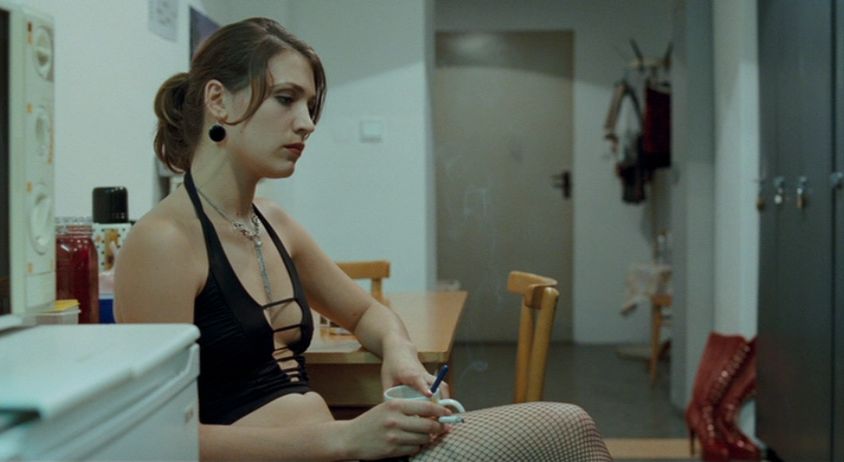
Irina Potapenko in Revanche (Gotz Spielmann - 2008)
Posted by Peter Nellhaus at 08:12 AM | Comments (1)
February 09, 2012
Car of Dreams

Graham Cutts and Austin Melford - 1935
Shanachie Region 1 DVD
Unless this is the only film blog read, you may already know that a new "For the Love of Film" blogathon has been announced just over a week ago. Hosted by Farran Nehme of Self-Styled Siren, Marilyn Ferdinand of Ferdy on Film, and Rod Heath of This Island Rod, this third outing will be devoted to writing about film, united by a common theme, and raising funds for film preservation. The blogathon will begin on May 13. Start saving those pennies now, because the goal is to make the recently rediscovered silent film, The White Shadow available for temporary online viewing. And you like to watch, don't you?
The story of a former white NBA player coaching basketball in an inner city high school twin sisters, one good, one evil, was considered lost until recently. Keep in mind that at this point, what we have is three of six reels. So why bother with a partially restored film? In this case, because of the work of one of Graham Cutt's uncredited assistants. Cutt's career is a strange one of starting more or less at the top, cofounding Gainsborough Studios, and directing the top productions, and ending his career with quota quickies, before totally retiring from any film activity while still in his 50s. Cutts is more famous for the filmmakers who worked with him early in their careers such as Michael Powell, Rowland V. Lee, and Charles Frend. Most famous of all was the multi-talented Assistant Director, Set Designer, Editor and Screenwriter - Alfred Hitchcock. The White Shadow was the second of three films Hitchcock made under Cutts.

Even with Car of Dreams are a couple of Hitchcock connections. Charles Frend, who began as an editor for Cutts, worked as Hitchcock's editor on several of the British films. As a director, Frend helmed the detective film, The Third Key, as well as several episodes of the TV series, Danger Man. John Mills' connection to Hitchcock is a bit more tangential, having a supporting role in Don Sharp's version of The Thirty-Nine Steps, considered by some to be one of the better remakes of a film first made by Hitchcock.
How much of Car of Dreams was directed by Cutts or screenwriter Austin Melford, I don't know. It is certainly a far better, more clever film that I had expected. Particularly noteworthy are a series of traveling camera shots in the films opening, and the use of sound, especially in scenes of a musical instrument factory secretary, and the instrument tester next door. One funny bit is a close-up of the secretary's hand, tapping on the desk, mimicking the sound of supposedly walking away to confer with her boss. There is also the film's title song, performed by the two leads while the rear screen projection changes from one locale to the next. Perhaps not original or innovative, but with a bit more imagination and style on what is essentially a quota production with a running time of about seventy minutes, The story is only in the movies as rich boy John Mills impulsively buys poor girl Grete Mosheim a Rolls-Royce, and pretends to be a chauffeur.
Given her history, Grete Mosheim would probably be seen to better advantage than in this film. On the other hand, John Mills is quite charismatic, in an atypical song and dance performance near the beginning of the film, weaving his way through a retinue of instrument makers. One aspect where it was obvious that pennies were counted is in the soundtrack, where a couple of the songs are repeated. The final shot of Mosheim and Mills driving away after all the misunderstandings have been cleared away might surprise and delight with an ending that anticipates a very similar film ending with John Travolta and Olivia Newton-John, forty-two years before Grease was the word.

Posted by Peter Nellhaus at 08:04 AM
February 07, 2012
Sword of Desperation

Hisshiken torisashi
Hideyuki Hirayama - 2010
AnimEigo Region 1 DVD
It should be noted that the literary source of Sword of Desperation is a novel by Shuhei Fujisawa. The author also provided the source material for Yoji Yamada's samurai trilogy. There are some thematic similarities here, but it helps to understand that in spite of the title, Sword of Desperation is not an action movie, although there is much sword fighting at the end of the film. Instead, Hideyuki Hirayama, like Yamada, has chosen to contemplate on what it means to be a samurai.
The climactic set piece near the end of the film has a bit more gushing blood, with sprays of red along white walls. Otherwise, Hirayama's film looks like it could have been made with little variation about fifty years ago. Unlike Takashi Miiike's version of 13 Assassins which includes elements that could not have been used in the original version, Hirayama's film might be described as neo-classical in its execution. I would place Sword of Desperation closer in spirit to something like the 1962 or earlier versions of Chushingura (The 47 Ronin), but on a more intimate scale.

Taking place in the Edo period, the film opens with a vassal, Kanemi, murdering the favored concubine, Renko, of the lord he serves. Fully expecting to be beheaded, Kanemi is instead put under house arrest for a year, after which he is asked to serve as chief bodyguard for the lord, Ukyo. Though never stated, a series of flashbacks partially reveal why Kanemi killed Renko. The bigger mystery, based on the protocol of the times, is why Kanemi is allowed not only to live, but to live in relative comfort, even as he shuts himself away from everyone.
In the first scene, a Noh performance is being observed by members of the feudal household. The basic themes are introduced regarding the manipulation of nature and appearances. It is Kanemi, and the niece by marriage who loves him unreservedly, who act in ways true to themselves, and are undisguised to others. Throughout the film, Hirayama devotes time to shots of clouds, the passing of time through the seasons, birds in flight, and snow melting into a river. A sunny close up of a spider web may hint at things to come, but it is benign in comparison the web of intrigue in the lord's mansion.
The title takes on a double meaning, but originally is Kanemi's term for a sword fighting technique he's developed. In the Noh play, dogs are hunted as a means to train to hunt for foxes. Kanemi uses a subtle, quick move of the wrist to snatch birds off trees with a long stick as an exercise that is used also in sword fighting. Kanemi's sense of loyalty and his ability as a master swordsman are also what trap him like the little bird we see in an earlier scene. Up until the end, Sword of Desperation is a muted, period drama where the patience of watching an elaborate scheme unfold pay off for the viewer, if not the film's characters.

Posted by Peter Nellhaus at 08:56 AM
February 05, 2012
Coffee Break

Charlton Heston and Mildred Dunnock in Bad for Each Other (Irving Rapper - 1953)
Posted by Peter Nellhaus at 08:46 AM | Comments (1)
February 03, 2012
Ocean Heaven

Haiyang tiantang
Xue Xiao Lu - 2010
Well Go USA Region 1 DVD
I wasn't quite prepared for the first shot of Jet Li in Ocean Heaven. I've been watching Li for about fifteen years, a combination of Chinese language and English language films, on the big screen and home screen. It could be the combination of the glasses and the flecks of white hair along his temples that did it, but Li looks so vulnerable. There was the sense that it wouldn't take much to knock over this guy, sitting in a small boat with his adult son.
At the very least, one gets a chance to see Li stretch his dramatic muscles as he approaches age 50. And give him credit for foregoing a paycheck to make the film. And even though Li is the most well known name, and the person most responsible for bringing attention to the film, he also surrender most of the attention to young Wen Zhang, the actor playing his son.
This is the second film written, and the first directed by Xue Xaio Lu. The previous film was Together, directed by Chen Kaige. What the two films share is a story line about a father and a son, and their uneasy relationship. In this film, Li plays a father, Xingchang, of an autistic young man, Dafu, who just turned 21. Xingchang is trying to minimize the effects what is revealed to be terminal cancer, while at the same time trying to find a future home for Dafu. Xingchang does maintenance at an aquarium where Dafu enjoys swimming with the dolphins, hence the title.

The film follow Xingchang's attempts to get Dafu to develop some independence, and a few life skills. Along the way, a traveling circus takes up residence at the aquarium, the equivalent of Sea World in Quingdao. Dafu temporarily becomes friends with a juggling clown, his first attempt at socializing on his own.
Xingchang and Dafu visit various potential institutions for Dafu's care. One very striking image takes place in a facility where the patients wear striped pajamas. The visual reference to a concentration camp is not hard to miss.
Li's involvement in the film may have been what attracted several other major names to participate in the modestly budgeted production. The casually framed cinematography is by Christopher Doyle. Kwai Lunmei plays the sad clown who befriends Dafu. Joe Hisaishi provided the film score. Having Jay Chou sing during the closing credits here is comparable to having Madonna providing vocals for a million dollar independent film stateside. Ocean Heaven may end up being better known for showcasing Wen Zhang, noted here for his goofy grin and fluttering fingers on his left hand. In one scene, Wen is dancing by himself in the rain, doing a little strut that made me think of Charlie Chaplin. The swimming scenes indicate a litheness suggesting that this young actor has more to show given the right opportunities.

Posted by Peter Nellhaus at 08:59 AM
February 01, 2012
Yakuza Weapon

Gokudo Heiki
Tak Sakaguchi & Yudai Yamaguchi - 2011
Well Go USA Region 1 DVD
In the middle of Yakuza Weapon is one scene I would encourage any serious film critic or historian to see. Or at least those people with an abiding interest in how scenes of action are filmed. The putative hero, Shozo, is pursued relentlessly by an powerful, international criminal organization. A large gang of killer nurses were unable to put Shozo down. Next, Shozo is in some building where he faces an army of guys in gray hoodies and jeans. Shozo shoots, punches, slices his way through these anonymous hired killers. The action starts as Shozo enters the building, going through rooms and hallways, and up a flight of stairs. What makes this scene remarkable is that it was done as a single take, almost four minutes long, staged by action director Yuji Shimomura.
I bring this up because of periodic discussions in some critical circles about how action scenes are filmed, especially when the current Hollywood model relies on lots of fast cutting, and extreme close-ups, all meant to convey a sense of chaos. In this case, watching a "Making of . . ." DVD supplement pays off in letting the viewer know that the scene I'm citing here was filmed as a single take, and perhaps more amazingly, it only took two times to get it right. So I'm calling it here: Yuji Shimomura is the Orson Welles of action directors, at least for his part of Yakuza Weapon.

The film is based on a manga by Ken Ishikawa. Nothing is as sustained or as inspired as that fight scene, but there are moments to savor. The story is about a young gangster, Shozo, who avenges the death of his father, a big time yakuza chief. Along the way, after being almost killed by the rival who murdered his father, Shozo is rebuilt by a secret government agency, with the ability to turn his prosthetic arm into a machine gun, and use an upper thigh as a cannon. That part of the film puts Yakuza Weapon loosely alongside other works of a uniquely Japanese genre of people with weapon body parts, like Machine Girl and Tokyo Gore Police.
At the very beginning, titles inform the viewer about the yakuza code of honor, of loyalty and chivalry. And while several characters talk about it, very little is on display here. I had to view this with a jaundiced eye, because even during the heyday of yakuza films in early Seventies, while some films presented stories of honor among the yakuza, there were also films such as those by Kinji Fukasaku that argued that there was no honor among these thieves.
My other favorite part of Yakuza Weapon is of the reunion of Shoza with fiancee, Nayoko. After demonstrating his ability to take on anybody with any weapon, Shoza meets up with Nayoko for the first time in about four years, and promptly gets shot at and beat up by this kimono clad woman. The relationship between Shoza and Nayoko, intense love and hate on her part, seeming indifference for him, recalls the stuff of great screwball comedies. Tak Sakaguchi has established himself in a series of action and fantasy films, but his scenes with Mei Kurokawa suggests an alternate type of film worth further exploration. As it stands, within the constraints of a two week shooting schedule and a budget less than a tenth of an average Hollywood film, Sakaguchi and company are to be commended for the bursts of imagination to be found in Yakuza Weapon.

Posted by Peter Nellhaus at 08:53 AM